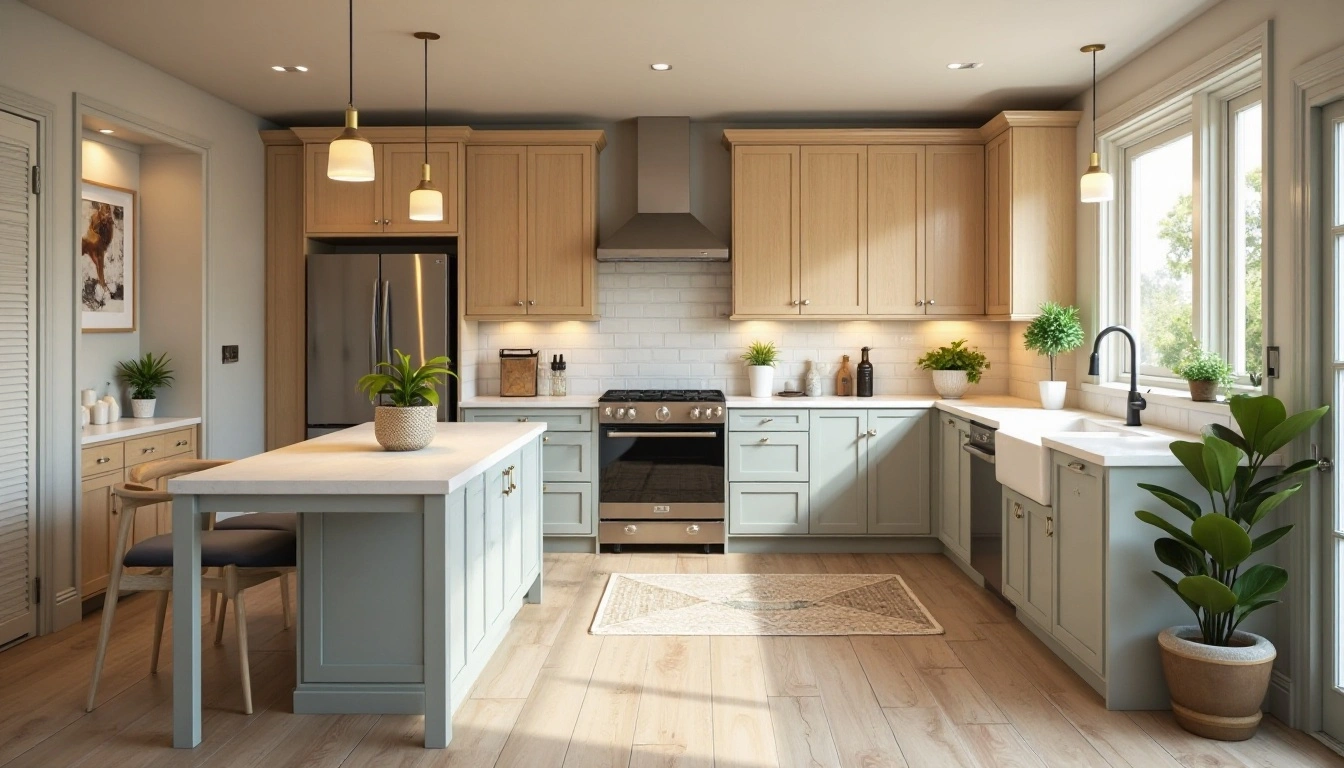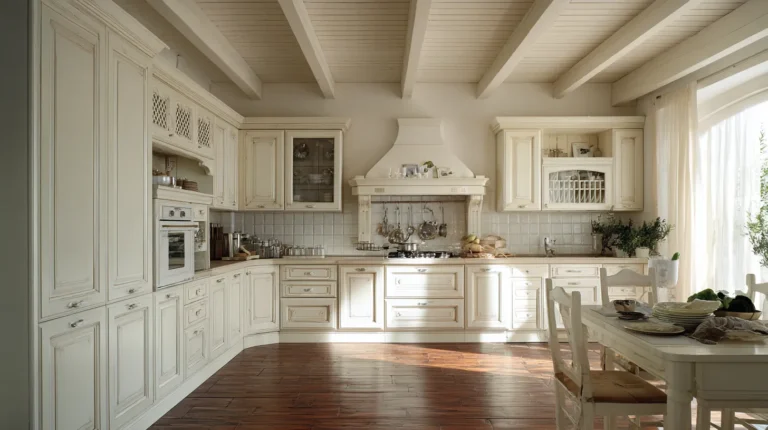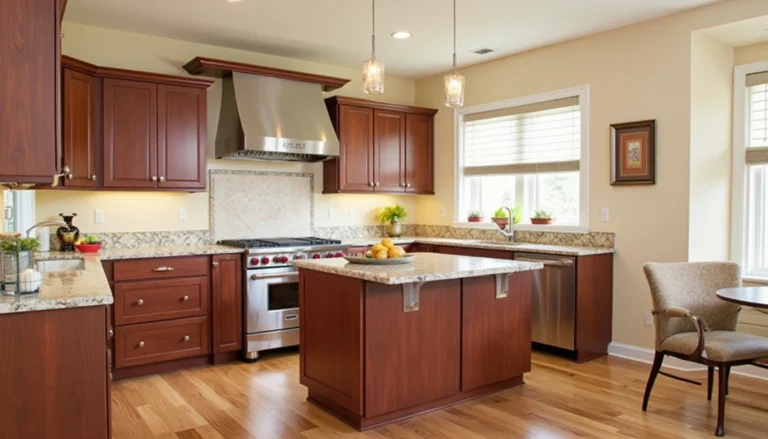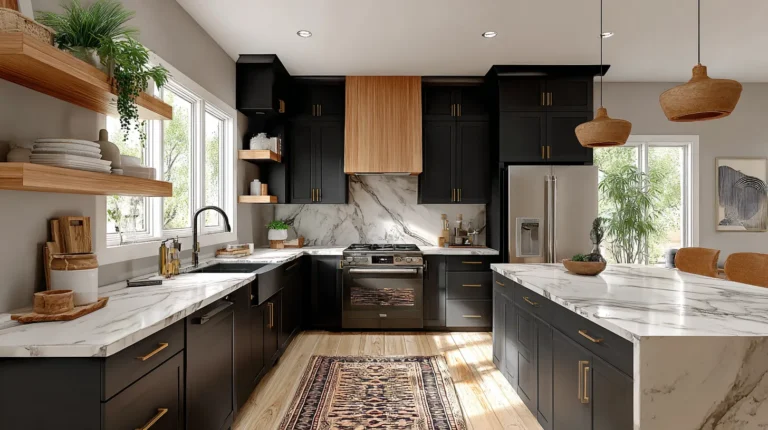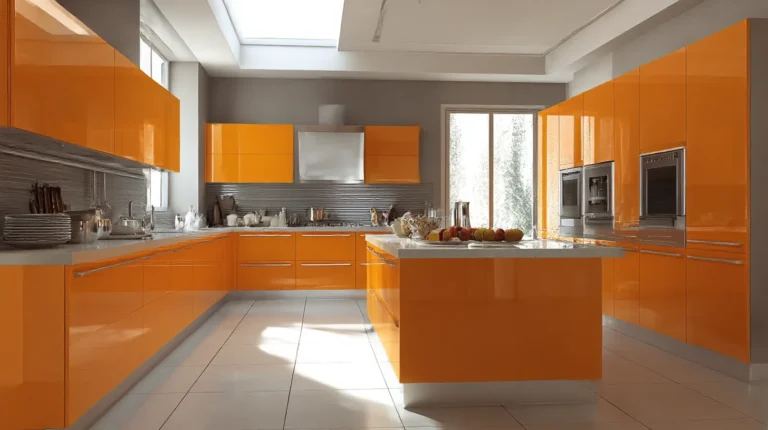Best cabinet and wood floor color combinations for kitchens
Have you ever walked into someone’s kitchen and immediately feel… something? Maybe it’s warmth. Maybe it’s calm. Or maybe it’s that subtle tension, like something’s just a little off. Chances are, that feeling has less to do with the appliances or layout, and more to do with a quieter detail: the color relationship between the floors and cabinets.
It’s underrated, wildly so, actually. Because this pairing isn’t just aesthetic. It sets the emotional rhythm of the entire room. Think about it: your floor is the foundation, literally and visually. Your cabinets? They’re eye-level anchors. Put the two in harmony, and everything in between just works, the lighting, the accents, even that wild backsplash tile you weren’t sure about.
This guide isn’t just a parade of trendy combos. It’s a walkthrough of what actually works — in real homes, with real light, and real human behavior in mind. We’ll break down 8 stunning pairings, sure. But we’ll also show you how they shift mood, impact space perception, and why some just click better than others.
Because great design isn’t just seen, it’s felt.
Light Brown Floors & Gray Cabinets: Understated Sophistication That Just Works
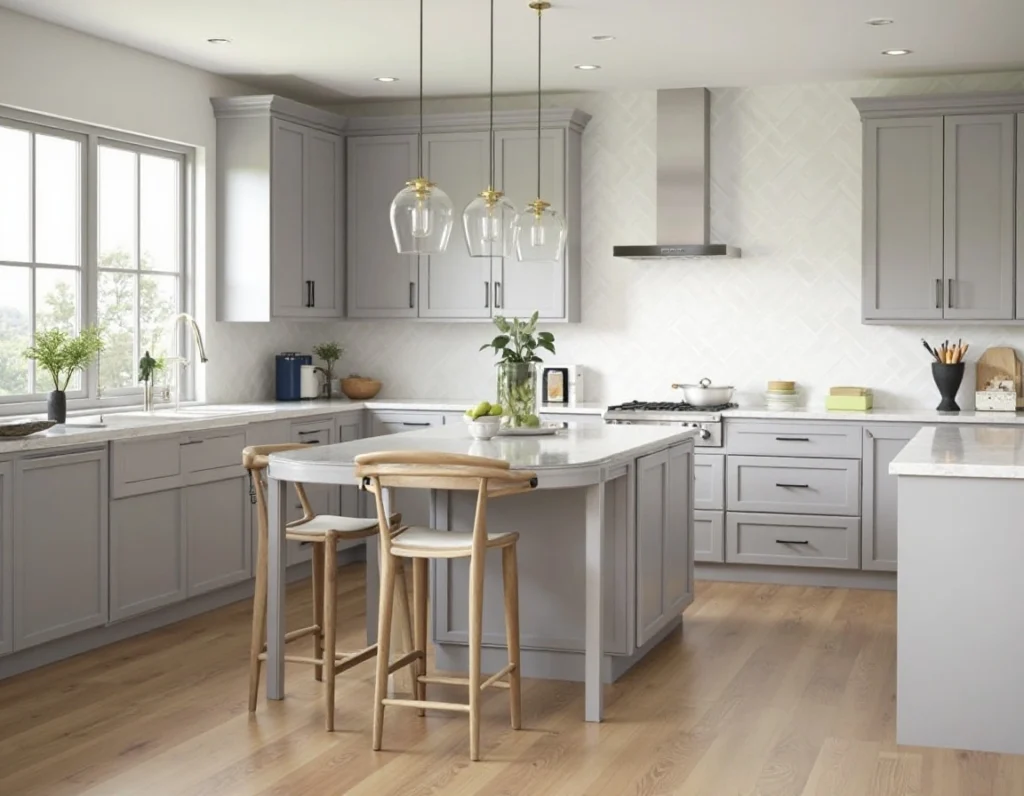
There’s something deeply grounding about light brown wood floors. They carry the quiet familiarity of nature, soft, warm, forgiving. Pair that with the cool, composed elegance of gray cabinets, and suddenly your kitchen becomes a masterclass in modern balance.
This combination works not because it’s trendy (though it is), but because it subtly bridges warmth and restraint. The light brown flooring brings in a sunlit, earthy feel that keeps things approachable. Meanwhile, gray cabinetry adds polish, a neutral but never boring counterweight that anchors the space with sophistication. You’re not screaming for attention here, you’re inviting a second, longer look.
Why It Works So Well
-
Natural Light Amplifier: Light brown wood floors reflect sunlight beautifully, while gray cabinets don’t overpower it. The result? A room that feels airy without being stark.
-
Color Tolerance: Gray is incredibly versatile. Whether your wood tones lean golden, taupe, or a little reddish, gray has a way of complementing without clashing.
-
Design Flexibility: This duo works across styles, coastal, Scandinavian, transitional, and even modern farmhouse. It adapts to your vision, not the other way around.
Best for: Transitional and Scandinavian-Inspired Kitchens
If your style lives somewhere between sleek minimalism and cozy functionality, this combo is your sweet spot. Add some brushed nickel hardware, a matte white backsplash, or even soft navy accents, they’ll all play nice here.
Does Gray Go With Oak-Toned Floors?
Yes, absolutely, with one caveat. Make sure the undertones align. Oak floors can lean orange, yellow, or red. Pair them with a neutral or slightly warm gray cabinet (like beige or taupe-gray) rather than a cool blue-gray to avoid a visual disconnect. If you’re unsure, sample paint swatches next to your floor in natural light first; the difference is more obvious than you’d think.
White Floors & Soft Green Cabinets: Light, Airy, and Almost Effortless
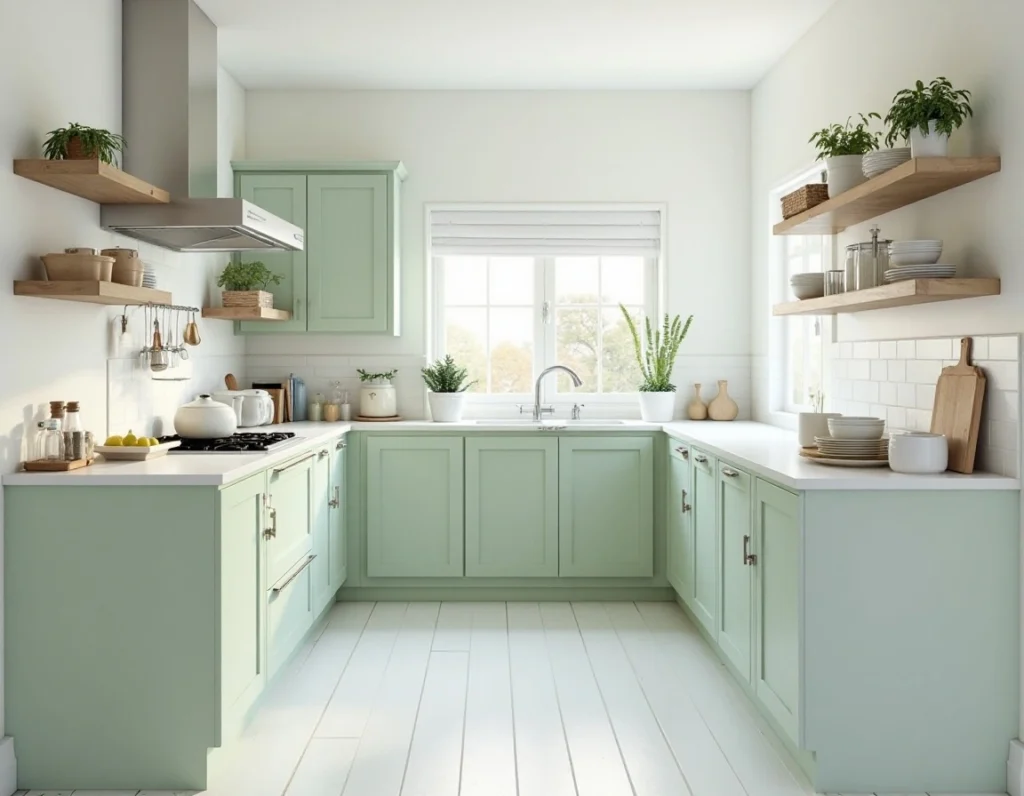
Step into a kitchen with white floors and soft green cabinets, and you’ll notice something hard to put into words. It’s not just bright, it’s peaceful. Like opening a window on a spring morning. There’s a reason this combo has quietly become a favorite among designers: it gives you the clean minimalism of a white kitchen without the sterility.
White flooring, whether painted wood, whitewashed oak, or pale laminate, bounces light around like magic. It makes spaces feel bigger, fresher, and unburdened. But alone, it can be a little… flat. That’s where soft green cabinets come in. Think sage, mint, eucalyptus, tones that whisper calm without fading into the background.
Why It Works So Well
-
Balance of Temperatures: The cool undertone of the white floor meets the natural warmth of green, creating a near-perfect equilibrium.
-
Mood Elevation: Green is psychologically tied to serenity and renewal, exactly the feeling most of us want when we walk into the kitchen at 7 a.m.
-
Backdrop Friendly: This palette plays well with everything from copper accents to open shelving and potted herbs.
Add Brass or Wood Accents for Warmth
Because this combo leans cool and airy, it benefits from grounded accents. Try brass hardware, butcher block counters, or woven textures to add warmth and avoid that “too crisp” feeling.
What Wall Colors Work with Green Cabinets?
Stick to soft neutrals that don’t compete. Cream, warm white, pale beige, or even a barely-there blush can complement green cabinetry beautifully. If you want contrast, a matte charcoal accent wall (opposite the cabinets) adds drama without stealing the show.
Dark Green Cabinets & Rich Wood Floors: Where Drama Feels Like Home
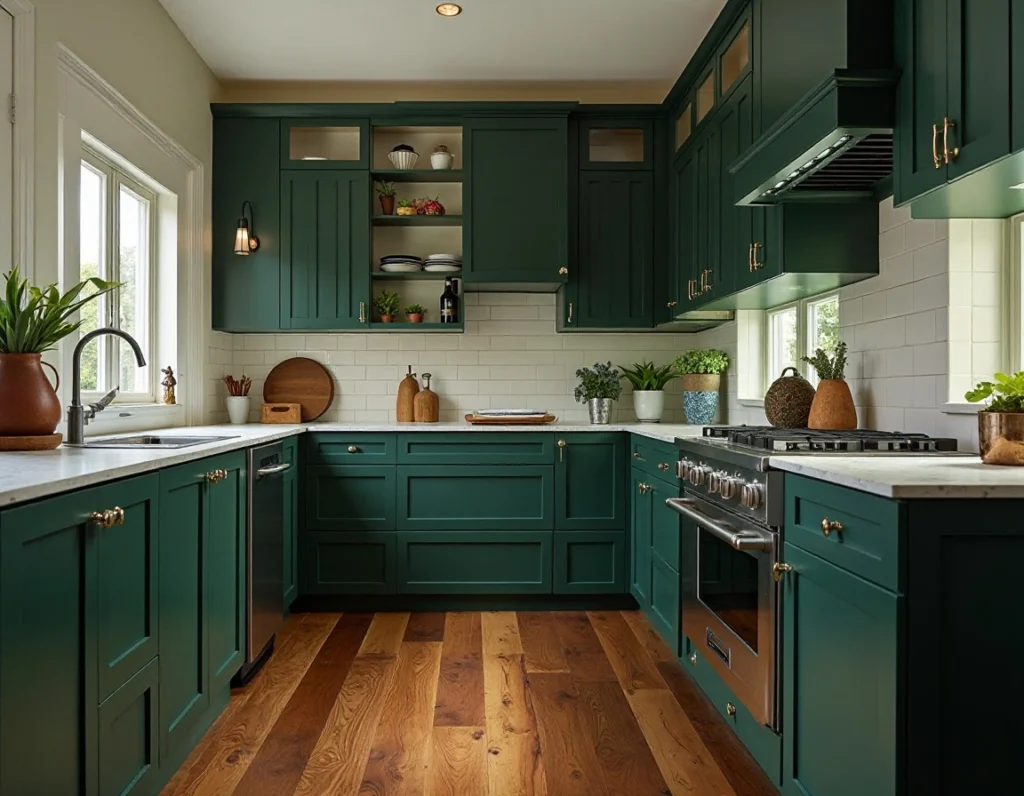
There’s a reason dark green kitchens are everywhere right now: they radiate quiet confidence. But when paired with rich wood floors? That’s not just trendy. That’s timeless. It’s the kind of kitchen that doesn’t beg for compliments, it just earns them.
The beauty of this combo lies in its layered depth. Deep green, think forest, hunter, or even blackened emerald, adds richness and mood. Meanwhile, rich-toned wood flooring (walnut, espresso oak, or even cherry) brings warmth that keeps the green from feeling too cold or cave-like. The result is a space that feels grounded, intentional, and slightly indulgent, like the design equivalent of a glass of red wine after a long day.
Why It Works So Well
-
Color Saturation Harmony: Both green and rich brown share a deep, earthy quality. They’re bold without clashing, and their natural roots make them feel instantly cohesive.
-
Cozy But Sophisticated: The combo manages to feel warm and enveloping without losing elegance — great for both entertaining and unwinding.
-
Perfect for Texture: Brass, leather, natural stone, or even matte black hardware all sing in this setting.
Style Fit: Rustic Luxe or Moody Traditional
This pairing excels in homes with strong character, older builds, bungalows, or even industrial lofts with a soft edge. Add open shelving, globe pendant lights, or vintage rugs to layer even more story into the room.
Will Dark Green Make My Kitchen Feel Smaller?
Only if lighting is an issue. In well-lit kitchens (especially with windows or skylights), dark green feels luxurious, not claustrophobic. To avoid visual shrinkage, balance it with light countertops, reflective backsplashes, or glass-front uppers. Or just lean into the mood and make it your cozy culinary cave.
White Cabinets & Distressed Brown Floors Clean Meets Character
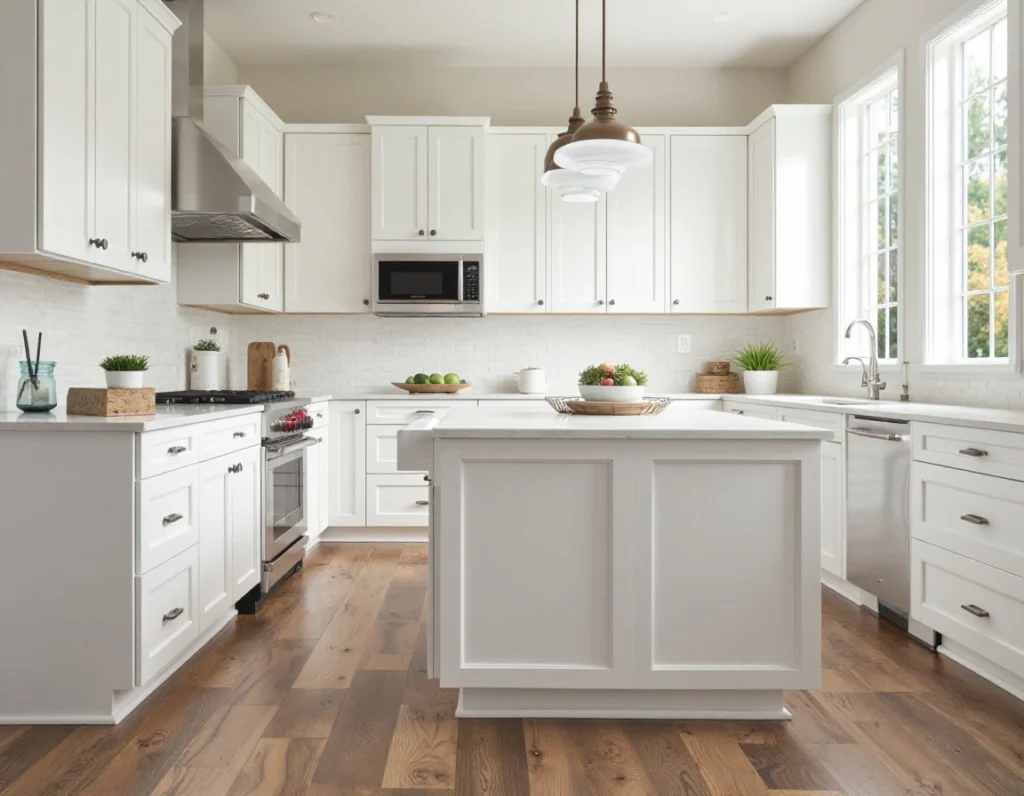
There’s a kind of magic in contrast, especially the kind that tells a story. That’s exactly what happens when crisp white cabinets meet distressed brown wood flooring. It’s the perfect balance between new and nostalgic, clean and worn-in, fresh and familiar.
White cabinets set a tone of brightness and openness. They reflect light, simplify the visual field, and provide that “clean slate” designers love. But let’s be honest, on their own, they can feel sterile. Enter: distressed brown floors. Scuffed edges, subtle grain patterns, maybe even a knot or two, the kind of imperfections that make a space feel human. Lived-in. Loved.
Why It Works So Well
-
Contrast with Context: The clean brightness of white makes the depth of the brown wood pop, and vice versa. It’s yin-yang, with better lighting.
-
Built-In Texture: The distressing in the floor adds tactile visual interest, which white cabinets gladly let take center stage.
-
Timeless Appeal: This combo isn’t locked into one trend. It plays well across rustic, modern farmhouse, even minimal Scandinavian spaces.
Where It Shines High-Traffic Kitchens and Family Spaces
This isn’t just a pretty pairing it’s practical. Distressed floors hide scratches and wear, making them ideal for homes with kids, pets, or life that happens in real time.
Is Distressed Flooring Still Trendy?
Yes, and more importantly, it’s functional. Trends may come and go, but the charm of floors that embrace imperfection? That sticks. The key is subtlety. Look for flooring with natural-looking wear (not overdone faux marks) to stay timeless rather than “theme-y.”
Multi-Tone Cabinets & Wood Floors: Unpredictable Harmony That Just Works
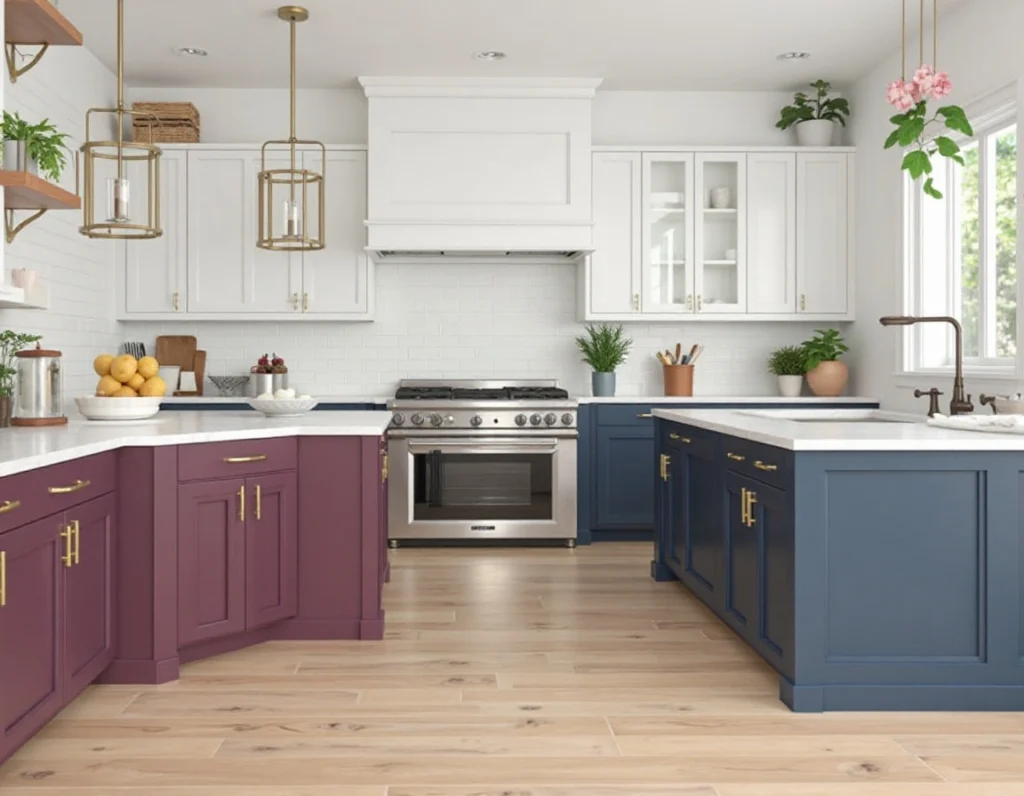
There’s a rule in design that’s often broken, and sometimes, that’s the point. Multi-tone cabinets paired with wood floors aren’t about matching. They’re about balancing variety. Done right, this combination creates a kitchen that feels curated, not chaotic, like every piece has a purpose, even if it wasn’t all bought at once.
Think navy lowers with white uppers. Or deep plum base cabinets against pale oak floors. The wood adds an earthy, stabilizing canvas that lets your color decisions shine without overwhelming the eye. The key isn’t uniformity — it’s intentional diversity. And when wood flooring anchors it all? The visual weight naturally settles.
Why It Works So Well
-
Built-In Contrast Control: Wood floors serve as a neutral grounding force when cabinets are playing multiple roles.
-
Design Flexibility: Want to swap out hardware or repaint uppers next year? This combo lets you evolve the space over time without gutting it.
-
Visual Zoning: Different cabinet tones can define zones — like island vs perimeter — without needing open concept walls.
Best for Eclectic, Creative, or Mid-Century Homes
If your design taste leans expressive, this combo gives you room to play, without losing cohesion. Add a butcher block counter, vintage light fixtures, or colorful backsplash tiles to tie the whole look together.
Can I Mix Upper and Lower Cabinet Colors?
Absolutely, but follow the 60-30-10 rule. Choose one dominant color (usually the lowers), a secondary color (uppers), and a small pop (accents). Stick to a shared undertone (warm or cool), and let the wood floor be the thread that holds the whole story together.
Black & White Cabinets with Cherry Wood Floors: Sharp Contrast, Soft Landing

At first glance, black and white kitchen cabinets sound… harsh. Like checkerboard tiles and tuxedo vibes. But pair them with cherry wood floors, and something shifts. Suddenly, it’s less “graphic design experiment” and more “grown-up, with edge.”
Cherry wood, especially when it leans toward that reddish-cocoa tone, has this way of warming things up without overwhelming. It’s rich, but not demanding. It grounds the black and white like a good bassline: always there, steady, holding the whole thing together without stealing the spotlight.
Why This Combo Hits Differently
-
It’s Unexpectedly Warm: You don’t usually associate black and white with comfort, but cherry adds just enough organic softness to make the room feel lived in, not staged.
-
Visual Rhythm: The eye travels naturally from white uppers to black lowers to rich, reddish floors — it creates a vertical flow that’s incredibly satisfying without being too obvious.
-
Design Flexibility: Want industrial pendant lights? Brass drawer pulls? A plant wall? This base combo lets you go minimalist or maximalist, depending on your mood.
Ideal For Kitchens That Want Bold Without Feeling Cold
This pairing thrives in spaces where clean lines matter, but so does feeling at home. It’s perfect for open-concept layouts that need visual anchors without losing warmth.
Is Cherry Wood Too Red to Feel Modern?
Depends on the finish. Glossy red cherry can feel a bit dated, yes. But if you go for a matte or low-sheen option, something closer to walnut or cocoa, you’ll get all the depth without the visual noise. Pair with simple cabinetry and soft textures to modernize the vibe.
Bright Blue Cabinets & Medium Brown Wood Floors: Bold Meets Balanced

Bright blue cabinets aren’t for the faint of heart and that’s exactly the point. They bring an instant shot of personality into the kitchen. But left unchecked, bold can quickly turn chaotic. That’s where medium brown wood floors come in: they anchor all that color with the kind of quiet confidence only wood can offer.
This combo lives in that rare sweet spot between playful and polished. The warm undertones of the floor temper the cool intensity of the blue, while the wood grain adds a bit of organic texture to keep things feeling, well, real. You’re not aiming for a showroom here; you’re creating a space that feels awake and alive.
Why It Works So Well
-
Color Contrast With Restraint: Blue pops against the brown, but because the floor isn’t too light or dark, the contrast stays friendly, not jarring.
-
Vibe Flexibility: Whether your blue is oceanic, teal, or cobalt, medium brown flooring plays nice. The combo can lean coastal, boho, or retro depending on your styling.
-
Emotional Lift: Blue evokes creativity and calm. Add warm wood, and you’ve got a space that’s energizing without feeling manic.
Best for: Creative Kitchens That Don’t Take Themselves Too Seriously
This is for the bold-but-intentional crowd. Open shelving, graphic tile, quirky hardware? They all find their place here, just let the wood floor do the grounding.
What Backsplash Works With Bright Blue Cabinets?
Stick to warmth or simplicity. White subway tile is classic, but cream or off-white can soften the contrast. Want something bolder? Try brass inlay tile or hand-painted ceramics, just echo the floor’s warmth somewhere in the pattern.
Pink Cabinets & Light Brown Wood Floors: A Soft Surprise That Sticks

Let’s be real, pink cabinets aren’t everyone’s first thought when designing a kitchen. For a lot of people, the word “pink” still triggers visions of bubblegum or birthday cake. But here’s the thing: muted, grown-up pink, the kind with a little gray or clay in it, is having a serious moment. And when you pair it with warm, natural wood floors? It doesn’t just work, it charms.
Light brown flooring tones down the whimsy and makes the pink feel intentional. Honest. Like it belongs there, not like it’s trying too hard. The wood adds grounding energy, something tactile and timeless, while the cabinets bring just enough color to feel fresh without veering into kitsch.
Why This Combo Feels Right
-
It’s Soft, Not Sweet: This isn’t cotton candy. It’s rose dust, desert clay, or faded terracotta, grounded pinks that play well with natural textures.
-
It’s Unexpected, in a Good Way: While everyone else is reaching for navy or charcoal, this combo quietly carves out its own lane.
-
It’s Emotionally Magnetic: There’s something about this pairing that makes people pause. It feels warm, lived-in, almost nostalgic, like the kitchen you wish you grew up in.
Best For: Design Risk-Takers With a Soft Side
If you’ve ever pinned a vintage rug next to brass fixtures and thought, “I want that vibe,” this duo might be your next move. Add open shelving, some greenery, maybe a soft linen curtain — you’ll have a space that doesn’t just look good but feels like you.
Will Pink Make My Kitchen Look Too Feminine?
Not if you ground it well. Think of pink as a color, not a statement. Paired with earthy floors, matte textures, or vintage hardware, it comes across as soulful, not girly. And honestly? Most people who walk into a well-designed pink-and-wood kitchen don’t say, “That’s feminine.” They say, “Wait, this actually looks amazing.”
Tips for Choosing the Right Kitchen Cabinet and Floor Color Combo
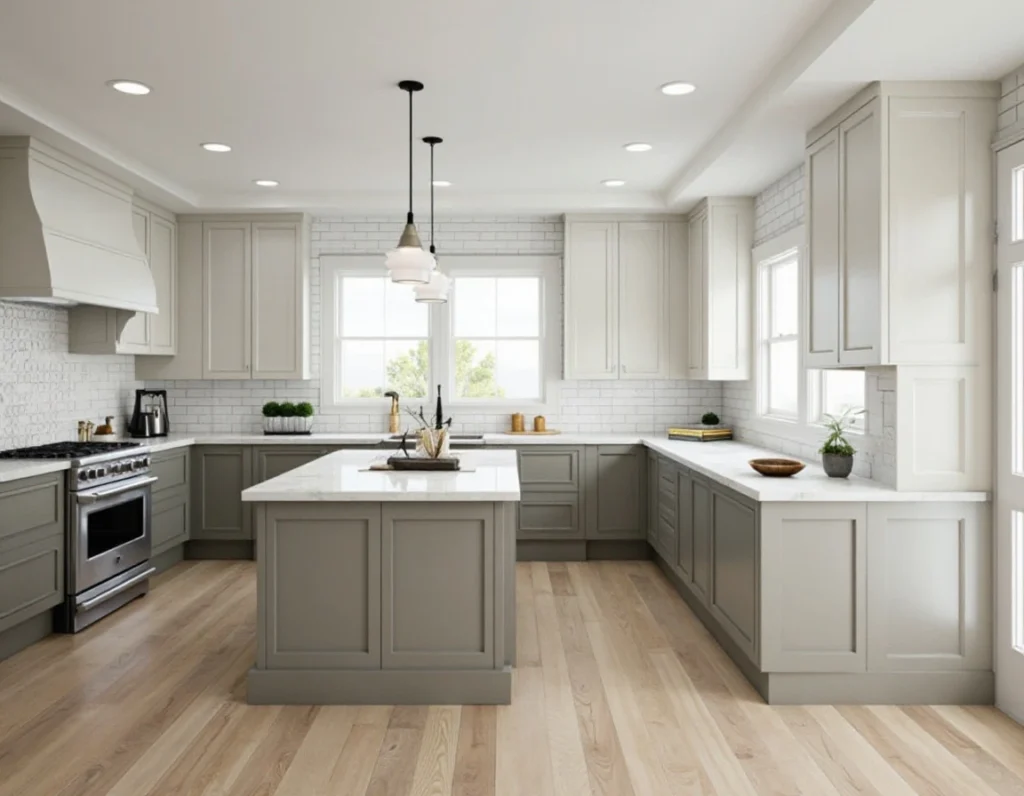
Design inspiration is great, but let’s be honest, standing in a showroom or scrolling through swatches can feel paralyzing. There are too many choices, not enough lighting, and your phone photos never quite match reality. So, how do you actually choose a floor and cabinet pairing that works in your home, not just on Pinterest?
Here’s where logic meets gut instinct.
Start With the Dominant Feature Then Complement
Ask yourself: what’s staying, and what’s flexible? If you already have floors you love, build your cabinet color around them. If your heart’s set on painted cabinets, let those lead. Don’t try to match, aim to balance. Cool with warm. Light with depth. Contrast with calm.
Mind the Undertones (They Matter More Than You Think)
Two browns can clash. So can two whites. The secret? Undertones. Your floor might have a red, yellow, or gray base, and if your cabinets don’t align, the whole space feels subtly “off.” Always test samples together, in your actual lighting. What looks neutral in the store might lean green at home.
Think About the Feeling You Want First — Not the Look
Do you want cozy? Crisp? Energetic? Grounded? Pick 2-3 emotional adjectives that describe how you want to feel in your kitchen. Then reverse-engineer colors that reflect those feelings. (Pro tip: Soft contrast = calm. High contrast = energy. Wood + color = grounded personality.)
The Three-Color Rule” for Safe, Stylish Balance
Limit your core palette to:
-
One dominant color (usually the cabinets or floor)
-
One secondary (counters, backsplash, or accent cabinetry)
-
One pop (hardware, décor, rugs)
More than that, and things can feel scattered. Less, and the room risks looking flat.
Should Floors Be Lighter or Darker Than Cabinets?
There’s no rule, only effect.
-
Lighter floors + darker cabinets = anchored, modern, grounded
-
Darker floors + lighter cabinets = airy, open, high-contrast
-
Similar tones = seamless, calm, potentially bland unless broken up with texture or metal
❓ What color kitchen cabinets go with hardwood floors?
Neutral colors like white, gray, or soft greens pair well with most hardwood floors. For contrast, dark cabinets suit light floors and vice versa. The key is balancing undertones; warm cabinets complement warm-toned floors, while cool tones work best with grays or ashy woods.
❓ Should my wood floor match my cabinets?
No, they shouldn’t match exactly. Instead, aim for contrast or complementary tones. Matching wood tones too closely can make the kitchen feel flat or heavy. Try pairing light wood floors with darker cabinets or mixing finishes for visual interest and depth.
❓ Should wood floors be lighter or darker than cabinets?
It depends on the desired effect. Lighter floors create an airy, spacious feel, especially with darker cabinets. Darker floors ground a kitchen and pair well with light cabinetry. Both can work; what matters is contrast and how the colors interact with light in your space.
❓ Should kitchen cabinets and the floor be the same color?
Not exactly. Cabinets and floors in the same color family can work if you vary the tone, grain, or finish. Exact matches can look flat and one-dimensional. For the best visual flow, create contrast while maintaining harmony through shared undertones or textures.
Conclusion: Color Pairing Isn’t Just Design, It’s Atmosphere
If you’ve read this far, you already know: choosing a cabinet and floor combo isn’t just about what “looks good.” It’s about how the room breathes. How it holds light. How does it make you feel the moment you step in — even when the dishes are still in the sink?
The best combinations aren’t about perfection. They’re about intention. Whether you lean minimalist, rustic, colorful, or classic, the right balance of tones can shift the entire feel of your kitchen, without a full renovation. Light with depth. Color with calm. Contrast with cohesion.
So take your time. Tape those swatches. Stand in a different light. Imagine the space not as a magazine spread, but as your everyday. Morning coffee. Quiet dinners. That random 11 p.m. snack.
Because when the floor and cabinets feel right together? Everything else just falls into place.

